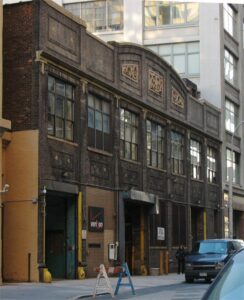Clubbing Culture & Studio 54
Long before hashtags and VIP guest lists, there was a velvet rope, and behind it, a revolution.
The disco club wasn’t just a place to dance. It was a sanctuary, a fashion runway, a theatre, a battleground, and a dream. And no club captured that magic more vividly, or more famously, than Studio 54.
But the culture began earlier and ran deeper than one legendary address. From The Loft and The Paradise Garage to Le Palace in Paris and Danceteria in New York, disco clubs were where people from all walks of life came to be free, be seen, and be together. No judgement. No rules. Just rhythm, sweat, light, and freedom.

Paradise Garage – a New York City discotheque located at 84 King Street in SoHo – operated from 1977 to 1987 and featured legendary resident DJ Larry Levan / Source: commons.wikimedia.org
The club was church. The dancefloor, holy ground.
Studio 54 may have become the most iconic symbol of disco excess, but it was also a beacon of possibility. A place where social boundaries evaporated under strobe lights. Where drag queens mingled with movie stars. Where you could be nobody, or become somebody. Fashion exploded under the disco ball, with glitter, feathers, sequins, leather, and eyeliner worn like armor. Entry wasn’t about money, it was about energy. You didn’t buy your way in. You radiated your way in.
Behind the scenes, DJs were the high priests of sound. People like Larry Levan, Nicky Siano, and Richie Kaczor didn’t just play records, they shaped emotions. Their transitions were spiritual. Their selections told stories. The sound system mattered. The acoustics mattered. The drop of a needle could lift a soul.
Clubs like The Paradise Garage went further, removing alcohol, creating membership-based entry, and centering the experience around the music. In these places, the DJ wasn’t behind the crowd. They were inside it. There was no stage, just community.
The Loft, started by David Mancuso in 1970, introduced the concept of the club as a safe space, particularly for the gay, Black, and Latin communities. It wasn’t commercial. It wasn’t a business. It was a party rooted in love, sound, and freedom. With audiophile-quality systems and homemade food, The Loft embodied the pure, democratic spirit of disco. It was about connection, not consumption.
Meanwhile, other cities began developing their own ecosystems. In Chicago, The Warehouse would later give birth to house music. In San Francisco, Trocadero Transfer and I-Beam carried the energy westward. Even in conservative environments, disco clubs sprang up as pockets of expression and rebellion.
“In nightlife you can become a star, while in the daytime you can just be a nobody.”
— Eddy de Clercq
At Studio 54, the club became a myth. It wasn’t just about music, it was theatre. Live horses, snow falling indoors, moon props flying from the ceiling. The club was a character in the story, and everyone inside played a role. It launched the careers of designers, stylists, and photographers. It made nightlife newsworthy, glamourous, and cinematic.
But beneath the sparkle, there was sincerity. There was unity. People came because it was one of the few places where you could exhale. The freedom of movement mirrored the freedom of identity. The intensity of the beat matched the urgency of living.

Ushuaïa Ibiza – crowned the world’s best club in 2024, a symbol of global clubbing culture today / Source: ibizarocks.com
Disco clubbing culture was the heartbeat of a generation – rebellious, radiant, alive. It gave rise to rituals of expression that still shape nightlife today: open-format sets, immersive lighting, sensory overload, and the notion that the crowd is part of the performance.
Even after the supposed “death” of disco, its club culture survived in house music, rave scenes, queer spaces, and global dance festivals. From Ibiza to Berlin to São Paulo, the echoes of The Loft and Studio 54 still pulse through speakers.
And most importantly, clubbing culture became one of the few public spaces where people could find chosen family. It wasn’t just about escaping the world, it was about building a new one, even if only for a night.
The 12″ single, born out of disco’s technical experimentation, revolutionized how music was consumed and created. DJs needed extended versions to keep the floor moving, and producers responded. Suddenly, the remix was born. It transformed records into living performances and set the foundation for today’s modern club culture. These singles gave producers and DJs creative control, and dancers more time to lose themselves in the beat.
Studio 54 may be gone, but the spirit of the dancefloor still lives on – in every club (regular or open-air), every after-hours party, every rooftop DJ set, every moment someone dances not just for fun, but for freedom. Few cultural movements can say they built a universe from nothing more than sound, light, and longing. But disco’s clubbing culture did exactly that. And every time someone steps onto a dancefloor today, they walk into a space that disco built.
CONTINUE EXPLORING THE CULTURAL INFLUENCE AND LEGACY OF DISCO:
• Disco Style: Fashion, Glamour & Identity
• The Art of the DJ: Turntables as Cultural Icons
• Disco in Film and Television: From “Thank God It’s Friday” to “Pose”
• From New York to the World: Disco’s Global Cultural Spread
• Flyers, Posters and Lightshows: The Visual Language of Disco
SOUND REFLECTIONS:
A few key tracks that encapsulate the essence of clubbing culture, where rhythm, identity, and community converge on the dancefloor:
“Girl You Need a Change of Mind” – Eddie Kendricks (1972)
“Rock Your Baby” – George McCrae (1974)
“Do It (‘Til You’re Satisfied)” – B.T. Express (1974)
“Spacer” – Sheila & B. Devotion (1979)
“Nights Over Egypt” – The Jones Girls (1981)
Full Spotify playlist: TOP 500 ESSENTIAL DISCO CLASSICS (1972-1979)
